Supported by the "S.Pellegrino Young Chef" international cooking competition.
Aomori travel report of the young chefs Supported by the "S.Pellegrino Young Chef" international cooking competition. -Day Two- | The Cuisine Press
2018.01.31

In this extensive ranch, egg-laying hens and sheep are raised as well. The ranch also offers experiential workshops for making sausage with pork and eggs, or cream puffs to convey the importance of life and food to children.
Hachinohe Municipal Gyosai Kouri Market: Hachinohe's kitchen
On the second day of the tour, Chefs Alessandro Rapisarda and Kenta Shibahara left their hotel at 6:30 A.M. to visit a morning market that has been known since the end of World War II as "Hachinohe's kitchen". They headed to Mutsuminato Station, a 30 minute drive from Hachinohe City. In front of the station, stalls sell an abundance of ocean-fresh seafood as well as processed food, with side dishes centering around the Hachinohe Municipal Gyosai Kouri Market, though the number of stalls was somewhat reduced due to the rain drizzling in that morning. The market is also known for local women fishmongers, who enthusiastically call out to potential customers.

Chef Rapisarda was excited about the lively market scene and took pictures of objects that caught his fancy with his tablet PC. Chef Shibahara asked vendors how local people eat the seafood and seaweed of the area.
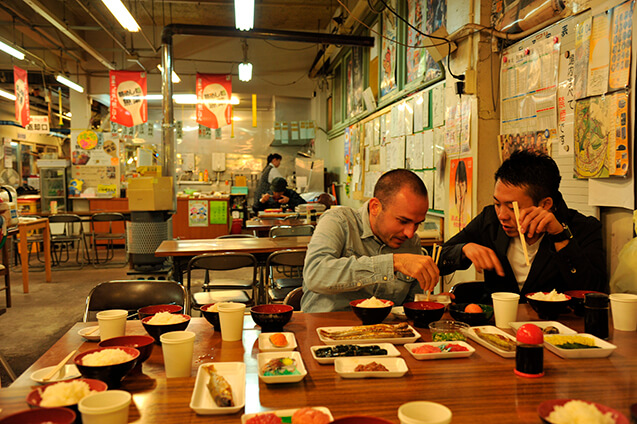
The Hachinohe Municipal Gyosai Kouri Market is also a popular spot for breakfast. Visitors can make their own set menu by bringing sashimi or sliced raw fish, grilled seafood and side dishes bought at stalls to the cafeteria, as well as ordering rice and miso soup. While enjoying the breakfast, Chef Shibahara expounded to Rapisarda on the ingredients and daily dishes unique to the Tohoku district and Japan.
※ Hachinohe Municipal Gyosai Kouri Market http://www.city.hachinohe.aomori.jp/index.cfm/10,4953,33,html
Yamada Orchard: the 100 year old apple tree

Apple orchards with fruit-bearing trees are a signature feature of autumn in Aomori. At the Yamada Orchard, in business for 4 generations in Owani Town at the southern end of the Tsugaru Region, early Fuji apples and Toki yellow apples are harvested. The two chefs experienced apple harvesting under the guidance of Toshihiko Yamada, owner of the orchard.
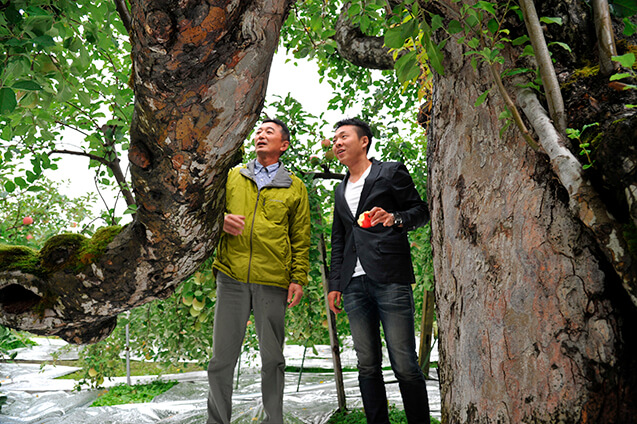
The Yamada Orchard has an old apple tree over 100 years old. As the branches spread more than 10 meters, it doesn't look like a single tree. Both chefs were lost for words in the presence of this somehow sacred tree, and just stared it, placing their hands on its thick trunk.
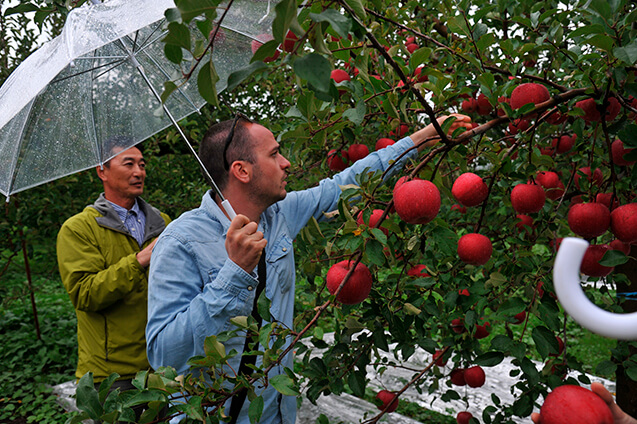
“Apples came to Aomori Prefecture in 1875. Around the same time, the cultivation of apples started in Owani. It was a Fuji variety with pronounced acidity that really brings out the sweetness. Here we focus on the cultivation of traditional apples rather than the improved varieties,” passionately stated the gentle-looking Yamada. The chefs listened attentively to his every word. Aomori has not only a rich natural environment, but also a special breed of people that protect and cultivate it. There we were able to encounter yet another aspect of the rich Aomori food culture.
※ Yamada Orchard http://www.appleyamada.com/
"Tsugaru Akatsuki no Kai": Experience the taste of home cooking from a real mother of Tsugaru.
The chefs then visited the "Tsugaru Akatsuki no Kai (meaning Tsugaru Dawn Club)," an organization established by 30 female farmers. They have collected and saved recipes of traditional local dishes by learning from elders and researching the association with local agriculture and food culture in order to revive Tsugaru's traditional cuisine. They also serve meals by advance reservation.
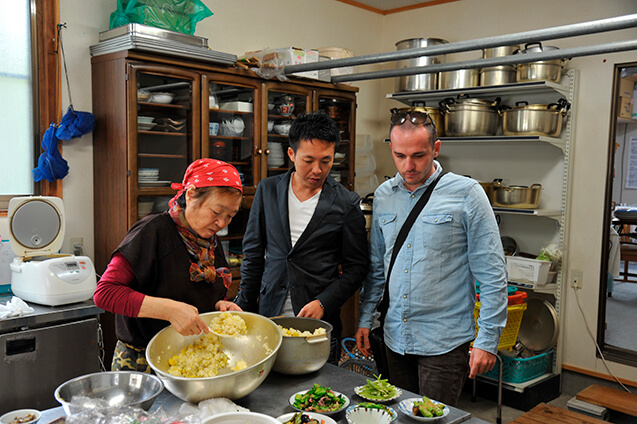
Upon arrival at the clubhouse, we noticed a delicious smell from the kitchen and saw aproned women lively preparing meals. What they cooked was home-style dishes using local ingredients, including succulent-looking vegetables.
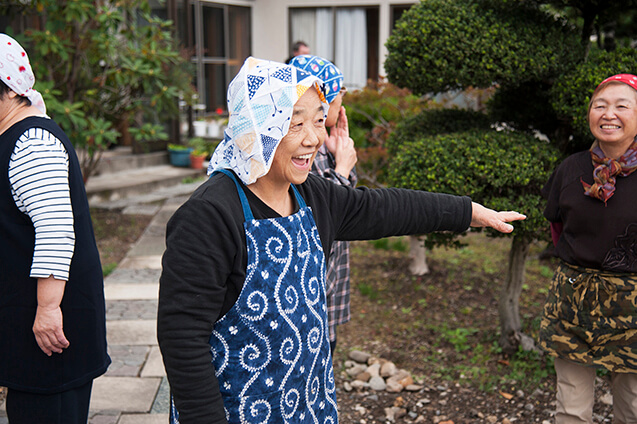
"For the vegetables, we basically only use local and seasonal produce and avoid the use of chemical seasonings, while sweetening stewed dishes with apples rather than sugar or mirin (sweet cooking rice wine) because in the past sugar was too expensive, but apples were readily available." said Ryoko Kudo, club representative.
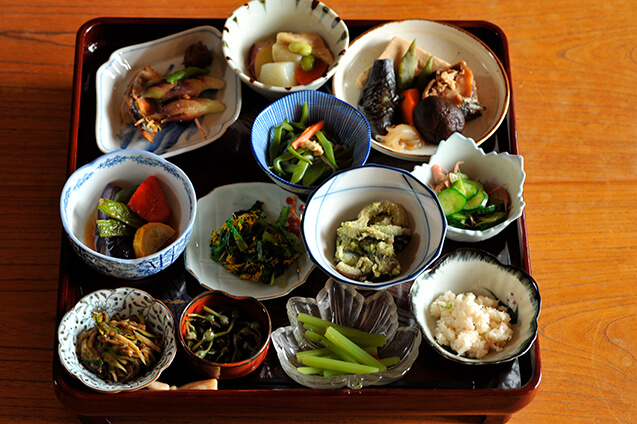
All dishes, including the Japanese pickles that represent Mom's cooking, were not extravagant, but rather comforting and loving. The mealtime flew by, as the chefs asked Kudo and the other women for the background of each dish. "I'm especially interested in preserved food using salt or fermentation." said Chef Rapisarda, finding several similarities between the local Japanese cuisine and the food culture of Italy, his home country.
※ Tsugaru Akatsuki no Kai http://www.umai-aomori.jp/know/sanchi-report/37.phtml
Hasegawa Natural Ranch: The secret is in the breeding!

The tour party arrived at "Hasegawa Natural Ranch," the last destination. Koji Hasegawa, the representative of the ranch, welcomed them, saying, "Thank you for coming so far from your home!" He gave the chefs a tour of the ranch, remarking, "We are the only ranch in Japan that uses this unique method for pig breeding."
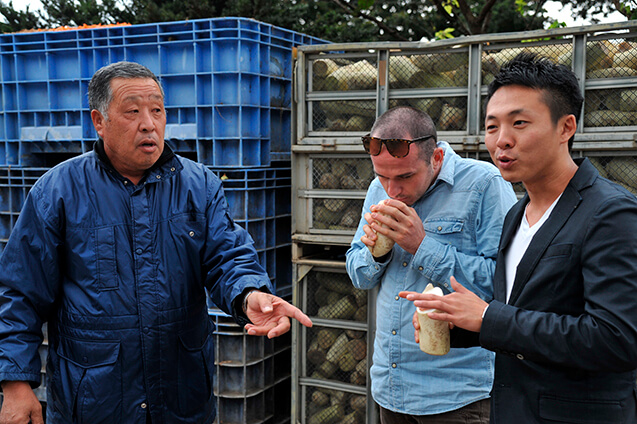
The first spot was the warehouse for storing swine feed. The massive mound of feed made with fermented chaff was warm, and the feed was so dry that it easily trickled though fingers, surprising the chefs. Pigs are fed this fermented feedstuff mixed with bread, potatoes, radishes etc. In the piggery, the happy hogs snorted impatiently for their meal.
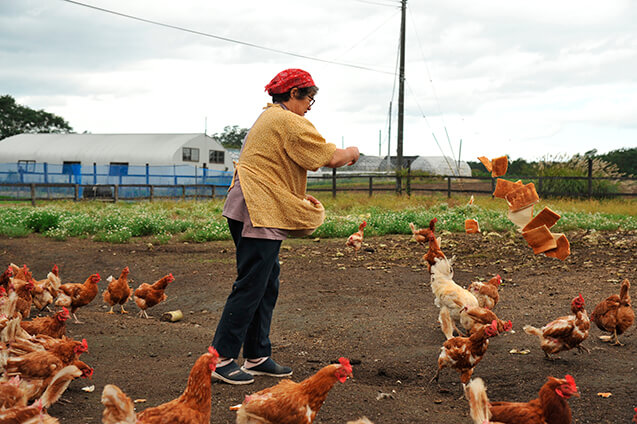
In this extensive ranch, egg-laying hens and sheep are raised as well. The ranch also offers experiential workshops for making sausage with pork and eggs, or cream puffs to convey the importance of life and food to children.
※Hasegawa Natural Ranch http://www.umai-aomori.jp/know/sanchi-report/25.phtml
Cooking ingredients encountered at Aomori
The two chefs experimented liberally with the ingredients produced by locals they discovered during the two-day trip in the kitchen of the experiential workshop.
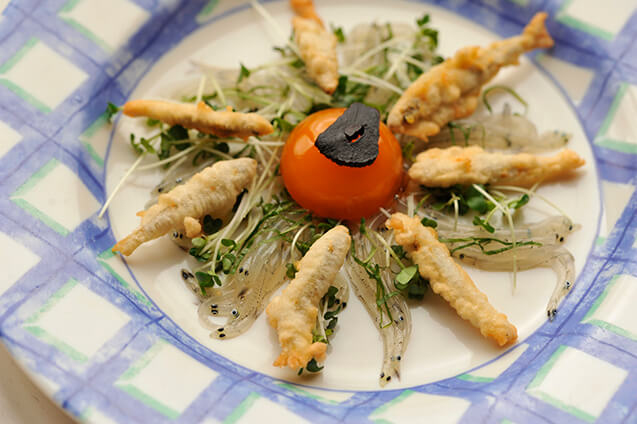
Chef Rapisarda prepared a fritto of fresh ice fish and lake smelt with marinated egg yolk and black garlic.
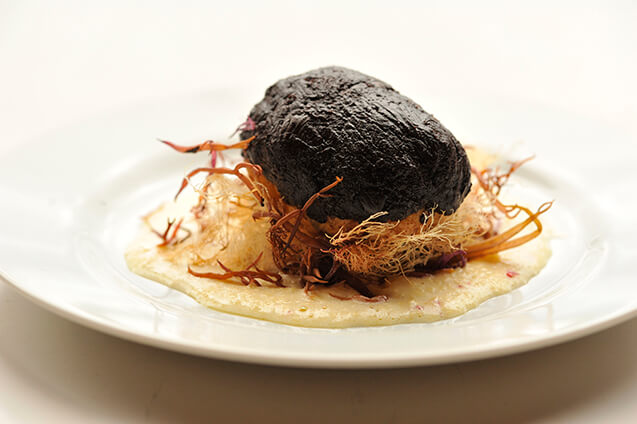
Chef Shibahara cooked Hamburger steak-styled Shamrock chicken accompanied with a sauce of apple and fresh egg, with mitten crab as the hidden flavor.
The two-day tour brought the young chefs into contact with Aomori's great food producers ranging from sea to mountains. We asked for their impression of the tour. For Chef Shibahara, the most impressive ingredient was the paste made from mitten crabs. "This paste can be applied to Italian cuisine, including simple pastas, and I feel more potential lies in using it for western cuisine rather than in Japanese food." Chef Rapisarda is particularly intrigued by the fermented black garlic and says, "I am going to promptly use it in my own cooking. It occurred to me it may even be utilized in desserts, as I get a hint of licorice from it. In addition, I would like to serve Japanese sake at my restaurant if I can."
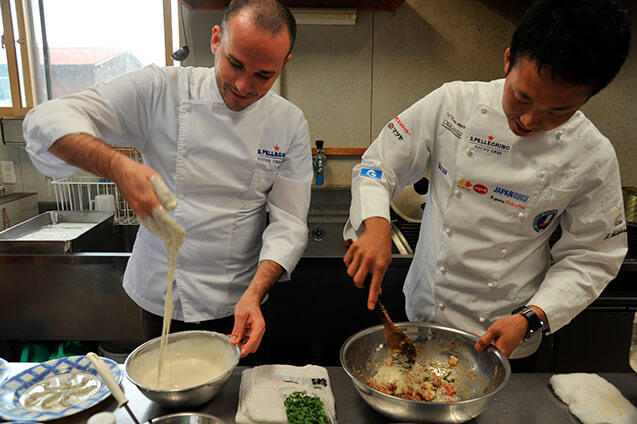
For these rising star chefs, the short tour in Aomori has certainly provided an educational opportunity for exchanging opinions about the potential of various ingredients, interactions with food producers and more.
※ What is "S.Pellegrino Young Chef"?
Founded in 1899, Sanpellegrino S.p.A. is the leading company in the beverage sector in Italy with its range of mineral waters, non-alcoholic aperitifs, drinks and iced teas. Since 2015 Sanpellegrino S.p.A. is also the organiser of this initiative called "S.Pellegrino Young Chef“.
The initiative consists of an international "Talent Scouting", open to young Chefs of legal age to a maximum of 30 years at the time of submission of their application. The purpose of the initiative is to support the principles of the culture of good food around the world, through a project that aims at identifying talented young chefs in order to celebrate their talent and encourage their professional growth.
"S.Pellegrino Young Chef 2018“ Grand Finale will be held in Milan in May 2018.
In the gastronomic world, being highly acclaimed at an international competition can be a significant step up for ambitious chefs, and this remarkable competition offers an incredible opportunity to a generation of young up and comers. In this competition, not just the flavor of a dish, but the chef's eye for selecting ingredients, cooking skills, ability to present beautifully and even the message a dish conveys will be evaluated.
Sanpellegrino S.p.A. and Nestlé Japan Ltd. have been making tremendous effort in supporting young culinary talents and uncover those individuals that will become this generation’s next stars.
https://www.sanpellegrino.com/youngchefapplication
https://www.nestle.co.jp/media/pressreleases/allpressreleases/20170615_spellegrino
- 1
- 2









